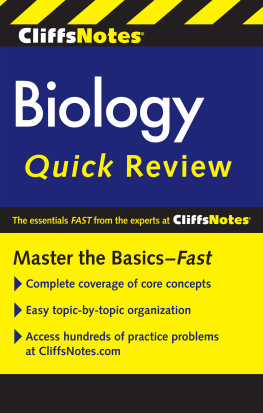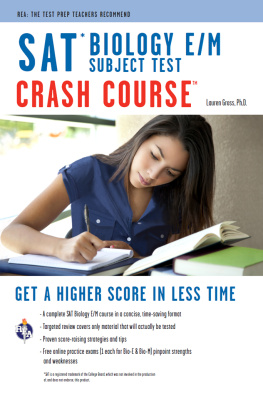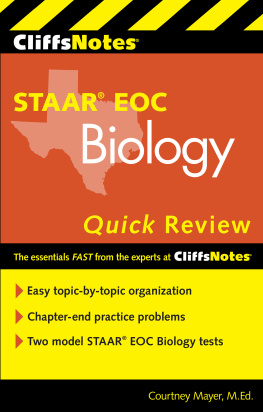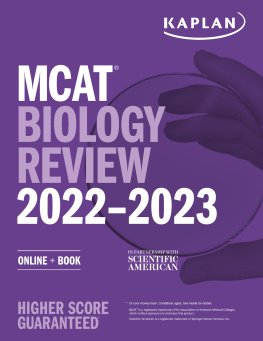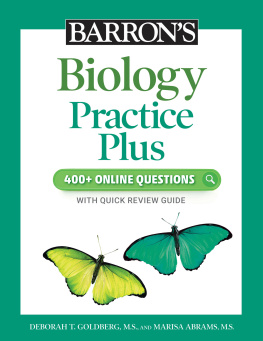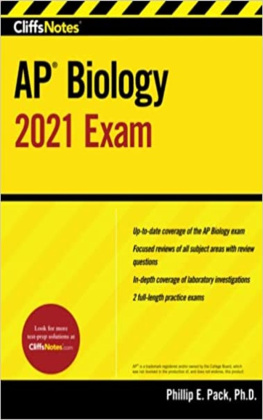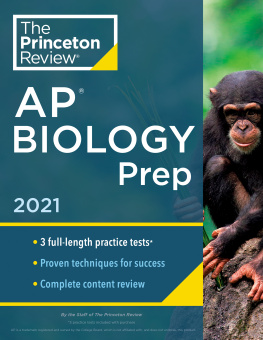About the Author Kellie Ploeger Cox, Ph.D., is on the science faculty of Hopkins School located in New Haven, Connecticut. | Editorial Executive Editor: Greg Tubach Senior Developmental Editor: Christina Stambaugh Copy Editor: Lynn Northrup Technical Editors: Scott McDougall and Scott Ryan Indexer: Potomac Indexing, LLC Proofreader: Elizabeth Kuball |
CliffsNotes Biology Quick Review, 2nd Edition
Copyright 2015 by Houghton Mifflin Harcourt
Publishing Company
All rights reserved.
Library of Congress Control Number: 2014948278
ISBN: 978-0-544-33167-9 (pbk)
eISBN: 978-0-544-33166-2
v1.1214
For information about permission to reproduce selections from this book, write to Permissions, Houghton Mifflin Harcourt Publishing Company, 215 Park Avenue South, New York, New York 10003.
www.hmhco.com
The publisher and the author make no representations or warranties with respect to the accuracy or completeness of the contents of this work and specifically disclaim all warranties, including without limitation warranties of fitness for a particular purpose. No warranty may be created or extended by sales or promotional materials. The advice and strategies contained herein may not be suitable for every situation. This work is sold with the understanding that the publisher is not engaged in rendering legal, accounting, or other professional services. If professional assistance is required, the services of a competent professional person should be sought. Neither the publisher nor the author shall be liable for damages arising herefrom. The fact that an organization or Website is referred to in this work as a citation and/or a potential source of further information does not mean that the author or the publisher endorses the information the organization or Website may provide or recommendations it may make. Further, readers should be aware that Internet Websites listed in this work may have changed or disappeared between when this work was written and when it is read.
Trademarks: CliffsNotes, the CliffsNotes logo, Cliffs, CliffsAP, CliffsComplete, CliffsQuickReview, CliffsStudySolver, CliffsTestPrep, CliffsNote-a-Day, cliffsnotes.com, and all related trademarks, logos, and trade dress are trademarks or registered trademarks of Houghton Mifflin Harcourt and/or its affiliates. All other trademarks are the property of their respective owners. Houghton Mifflin Harcourt is not associated with any product or vendor mentioned in this book.
INTRODUCTION
T his book provides a concise, comprehensive review of the key concepts of the study of living things. Topics covered in detail include the atoms and molecules that comprise all living organisms; the central dogma of biology; the three central molecules (DNA, RNA, and protein); and the most vital biological processes, such as mitosis, meiosis, and reproduction. Subdisciplines of biology are also thoroughly explained, including taxonomy, anatomy, and ecology. A review of genetics and evolution includes the controversial and groundbreaking theories of Gregor Mendel and Charles Darwin. The biochemical processes of respiration and photosynthesis are discussed in detail for comparison, and several chapters focus on plant structure and function. Due to the increasing importance of recombinant biotechnology and stem cell research, highlights common molecular biology techniques used to identify genetic disorders and combat disease in humans. Finally, this book provides several chapters reviewing comparative anatomy of humans and other organisms.
CliffsNotes Biology Quick Review, 2nd Edition, includes bare-bones information about a wide variety of biological processes, from microbiology and biochemistry to evolution and ecology.
Why You Need This Book
Can you answer yes to any of these questions?
- Do you need to review the fundamentals of biology fast?
- Do you need a course supplement to aid your study of biology?
- Do you need a concise, comprehensive reference for your biology studies?
If so, then CliffsNotes Biology Quick Review, 2nd Edition, is for you!
How to Use This Book
You can use this book in any way that fits your personal style for study and review; you decide what works best for your needs. You can either read the book from cover to cover or just look for the information you want and put the book back on the shelf for later. Here are just a few ways you can search for topics:
- Look for areas of interest in the books Table of Contents, or use the Index to find specific topics.
- Flip through the book, looking for subject areas at the top of each page.
- Get a glimpse of what youll gain from a chapter by reading through the Chapter Check-In at the beginning of each chapter.
- Use the Chapter Check-Out at the end of each chapter to gauge your grasp of the important information you need to know.
- Test your knowledge more completely in the Review Questions and look for additional sources of information in the Resource Center.
- Use the Glossary to find key terms fast. This book defines new terms and concepts where they first appear in the chapter. If a word is boldfaced, you can find its definition in the Glossary.
- Flip through the book until you find what youre looking for. We organized this book to gradually build on key concepts.
Hundreds of Practice Questions Online!
Go to www.cliffsnotes.com/sciences/biology-quizzes for hundreds of additional biology practice questions to help you prepare for your next quiz or test. The questions are organized by this books chapter sections, so its easy to use the book and then quiz yourself online to make sure you know the subject matter. Go to www.cliffsnotes.com to test yourself anytime and find other free homework help.
Chapter 1
THE SCIENCE OF BIOLOGY
Chapter Check-In
- Identifying the characteristics of living things
- Mapping out the scientific method
B iology is the study of living things. It encompasses the cellular basis of living things, the energy metabolism that underlies the activities of life, and the genetic basis for inheritance in organisms. Biology also includes the study of evolutionary relationships among organisms and the diversity of life on Earth. It considers the biology of microorganisms, plants, and animals, for example, and it brings together the structural and functional relationships that underlie their day-to-day activities. Biology draws on the sciences of chemistry and physics for its foundations and applies the laws of these disciplines to living things.
Many subdisciplines and special areas of biology exist, which can be conveniently divided into practical and theoretical categories. Types of practical biology include plant breeding, wildlife management, medical science, and crop production. Theoretical biology encompasses such disciplines as physiology (the study of the function of living things), biochemistry (the study of the chemistry of organisms), taxonomy (classification), ecology (the study of populations and their interactions with each other and their environments), and microbiology (the study of microscopic organisms).
Characteristics of Living Things
Defining a living thing is a difficult proposition, as is defining life that property possessed by living things. However, a living thing possesses certain properties that help define what life is.
Complex organization
Living things have a level of complexity and organization not found in lifeless objects. At its most fundamental level, a living thing is composed of one or more

